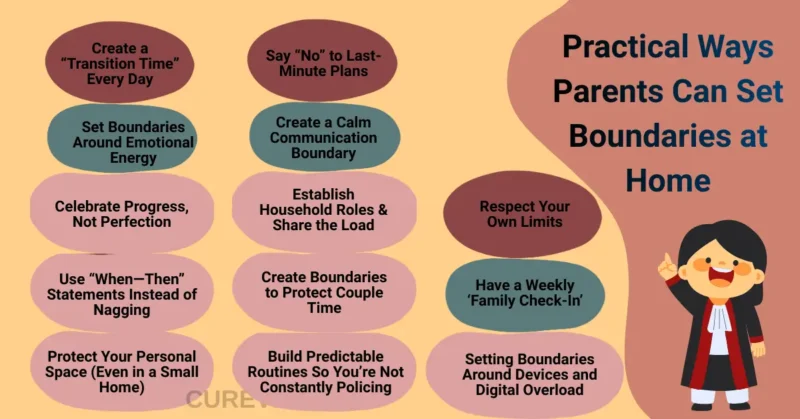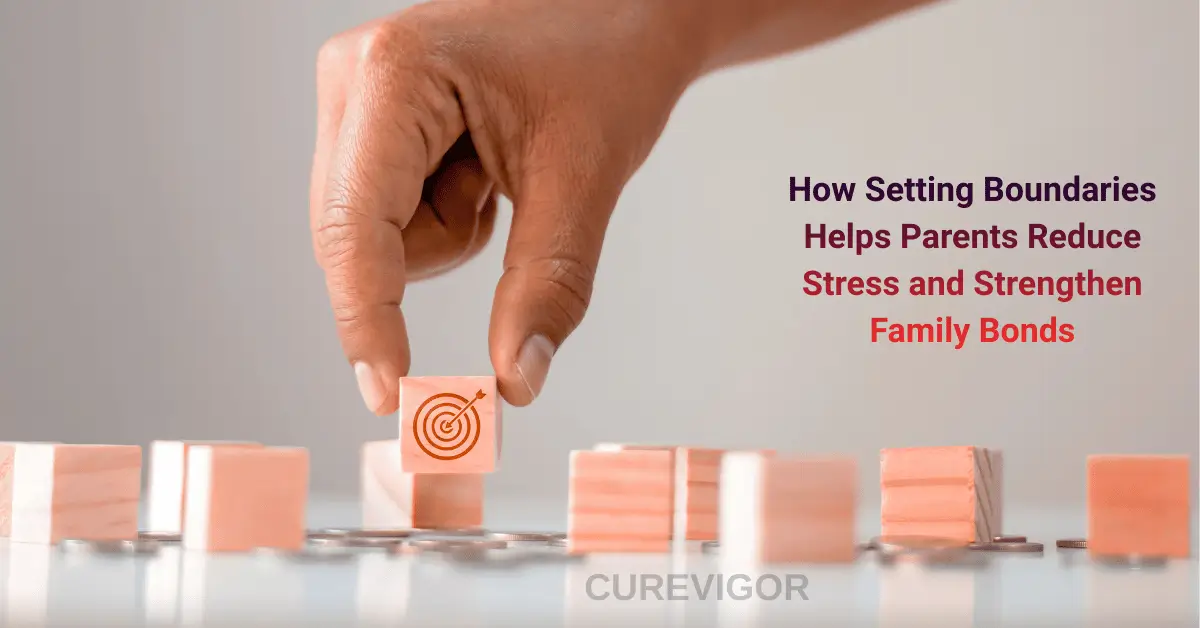Learn why setting boundaries is essential for parents seeking less stress and more meaningful family connections, and discover how setting boundaries can lead to a calmer, more connected home overall.
Thank you for reading this post, don't forget to subscribe!When Parents Learn to Set Boundaries, Everything Changes
As busy parents, our days often feel like a cycle of giving—giving time, energy, solutions, attention, and care. But what happens when we continue to give without refilling ourselves?
We feel exhausted… resentful… overwhelmed… and disconnected from the joy of parenting.
I know this because I lived it.
Between my roles as a wellness guide, a Listener Coach, and a parent, I once believed that being available all the time made me a good parent and a good person. I said “yes” even when my body whispered “no.”
I took on extra tasks at home, emotionally supported everyone around me, and didn’t leave space for myself.
Eventually, I realized something powerful:
You can’t build a peaceful family life without setting boundaries.
When I started saying “yes to myself,” everything shifted. My stress lowered. My patience grew. My relationships—at home and work—became stronger, healthier, and more respectful.
This blog shares what I learned, what worked for me, and how you, too, can transform your family life by learning to set boundaries without guilt.
Why Parents Must Set Boundaries: The Real Reason Behind Stress and Overwhelm
Most parents feel stressed because they live in constant response mode:
- Kids need help
- The house demands attention.
- Work deadlines follow you home.
- The extended family expects time.
- Your partner needs support.
- And somewhere at the bottom of the list… you.
Without setting boundaries, everything becomes urgent and overwhelming.

But when you set boundaries, your life moves from reaction to intention.
Here’s what actually happens when you don’t set boundaries:
- You feel emotionally drained.
- You have less patience with your kids.
- You get irritated easily.
- You lose chunks of personal time.
- Family communication becomes tense.
- Your needs are pushed aside.
- Everyone assumes you’re “fine”
Feeling familiar? It’s not because you’re failing.
It’s because you’re operating without limits.
Why Setting Boundaries Matters
Healthy boundaries help you:
- Protect your energy
- Stay emotionally stable
- Prevent burnout
- Create a structure at home.
- Build mutual respect
- Improve communication
- Teach children responsibility
- Strengthen family connections
When parents set boundaries, the entire home benefits.
What Does It Mean “Setting Boundaries” as a Parent?
Many people think boundaries mean being strict or controlling, but that’s not true.
In reality, boundaries are clarity, not control.
A boundary simply means:
“This is what I can give, and this is what I can’t.”
For parents, boundaries can be emotional, time-based, energy-based, or practical.
Examples of healthy parental boundaries
- “I am resting for 20 minutes; please go play independently.”
- “I can help with homework, but I won’t redo your work for you.”
- “After 8 pm, I am not doing house chores.”
- “I will not raise my voice. Let’s talk calmly when we’re both ready.”
- “No work messages after dinner.”
- “I need my weekly self-care time.”
Setting Boundaries helps your family understand your limits—and respect them.
My Personal Story: How Setting Boundaries Changed My Family Life
For years, I played the role of the “yes parent.”
Yes, I’ll help.
Yes, I’ll stay awake late.
Yes, I’ll carry the extra emotional load.
Yes, I’ll manage everything at home… because it must be done, right?
But what I didn’t realize was this:
By always saying yes to everyone else, I was saying no to myself.
The turning point
I remember a day when I felt exhausted after work, yet the moment I stepped through the door, the demands began:
- My child needed help.
- The kitchen was a mess.
- Work messages kept popping.
- Family called with new expectations.
And I broke down.
That day I promised myself:
“From now on, I accept setting boundaries to protect my peace.”
I started with small changes:
- A fixed “quiet hour” after work
- Clear division of chores
- Saying no to extra commitments
- Weekly self-care time is blocked in the calendar.
- No screen time or work after 9 pm
- Letting others help instead of doing everything myself
Within weeks, I noticed:
- I felt calmer
- My relationships improved
- My child became more independent.
- I wasn’t irritated as often.
- I enjoyed family time more.
- I had energy for myself again.
Boundaries didn’t distance me from my family—they brought us closer.
How Setting Boundaries Reduces Stress for Busy Parents

Setting boundaries decreases our stress naturally.
Here’s how:
1. Stop trying to do everything
Parents often carry invisible responsibilities. Setting Boundaries helps distribute the load.
2. Get more emotional space
This helps avoid burnout and emotional outbursts.
3. Protect your time
Scheduled “me time” gives you space to recharge.
4. Have predictable routines
Clear routines reduce mental load and decision fatigue.
5. Create healthier communication
Instead of reacting with frustration, you respond with clarity.
6. Leave guilt behind
Saying yes to yourself stops feeling selfish—it becomes necessary.
The result?
A calmer, more centered version of you… Which benefits your family the most?
How Setting Boundaries Strengthens Family Bonds
Many parents fear that boundaries will distance them from their children or partner.
But the opposite is true.
Here’s how boundaries build connection:
1. They create mutual respect
Children learn to respect your limits—and their own.
2. They improve communication
When everyone understands expectations, fewer conflicts arise.
3. They teach independence
Kids become more responsible, confident, and capable.
4. They build emotional safety
Healthy boundaries prevent criticism, guilt-tripping, and emotional exhaustion.
5. They strengthen trust
Family members understand your needs and know what to expect.
6. They make family time more meaningful
Because you’re not drained, you show up with warmth and presence.
Boundaries don’t block love—they protect it.
Practical Ways Parents Can Set Boundaries at Home
Setting boundaries at home is not about being strict—it’s about creating a calm, predictable, and emotionally safe environment where everyone’s needs matter, including yours.

Here are practical, simple, and parent-friendly ways to set boundaries that truly work in a busy household.
1. Create a “Transition Time” Every Day
Many parents walk straight from work stress into family responsibilities without a moment to breathe.
This creates irritation, overstimulation, and exhaustion.
Boundary Example
“Give me 15 minutes to change, settle, and recharge. After that, I’m fully yours.”
Why It Works
- Kids know what to expect.
- You release the day’s stress.
- You avoid snapping or reacting emotionally.
Even a small ritual—washing your face, changing clothes, or drinking warm tea—creates emotional space.
2. Build Predictable Routines So You’re Not Constantly Policing
Parents often get overwhelmed because they repeat the same instructions every day:
“Do your homework…”
“Clean up your toys…”
“Get ready for bed…”
Routines are boundaries that run automatically.
Practical Routine Ideas
- A fixed homework hour
- Toy pickup before dinner
- No devices at mealtimes
- Reading before bed
- Family “quiet hour”
Why It Helps
Kids stop relying on reminders and start relying on structure.
3. Set Boundaries Around Emotional Energy
Parents often absorb everyone else’s emotions—kids, partner, extended family.
But you cannot regulate your home if you’re constantly dysregulated.
Boundary Example
“I want to help you, but I can’t talk when I’m upset. Let me calm down first.”
Why It Works
- Models emotional intelligence
- Prevents arguments
- Creates safe communication habits
This is a powerful boundary that children will copy as they grow.
4. Use “When—Then” Statements Instead of Nagging
This is a gentle, respectful way to set boundaries with kids.
Example
- “When you finish your homework, then we’ll play together.”
- “When your things are picked up, then you can use your tablet.”
- “When you speak calmly, then I can listen.”
Why It Works
- Clear cause-and-effect
- No yelling
- Teaches responsibility
It shifts the responsibility from you chasing them to them managing themselves.
5. Protect Your Personal Space (Even in a Small Home)
Parents often feel guilty asking for space, but it’s essential.
Ways to Create Space
- A specific chair that’s “your corner”
- A rule that closed doors mean “please knock”
- A set time daily, where you are not to be interrupted
Boundary Script
“I love you, but I need a little quiet time. I’ll be available again at ___.”
This teaches children that personal space is normal, not selfish.
6. Establish Household Roles and Share the Load
A boundary is not just “what I won’t do”—it’s also “what others can and should do.”
Examples
- Kids put laundry in the basket.
- Partner handles bedtime or mornings.
- Everyone clears their own dishes.
- Kids pack their own school bags the night before
Why It Helps
- Teamwork increases
- You stop carrying invisible labor.
- Responsibility becomes a family value.
This boundary dramatically reduces your mental load.
7. Say “No” to Last-Minute Plans
Parents get overwhelmed when they bend their schedule to accommodate others—extended family, guests, school demands, or sudden favors.
Boundary Example
“I appreciate the invite, but I can’t commit on such short notice.”
Why It Works
You protect your energy, weekends, and family rhythm.
8. Setting Boundaries Around Devices and Digital Overload
Screens drain attention and increase stress for kids and parents.
Practical Digital Boundaries
- No phones during meals
- No late-night scrolling in bed
- Social media limits for everyone
- Screen-free family activities
- Parents model healthy use.
Boundary Script
“I’m putting my phone away now because I want to be fully present. Let’s all do the same.”
Kids follow what you model—not what you say.
9. Create a Calm Communication Boundary
Yelling creates fear, not respect.
But silence or emotional withdrawal also confuses children.
Boundary Example
“We don’t shout over each other in this house. We wait, we listen, we talk.”
Why It Helps
- Builds emotional safety
- Reduces conflict
- Teaches listening skills
This is one of the most life-changing family boundaries.
10. Have a Weekly ‘Family Check-In’
A short 10–15 minute family meeting builds healthy family habits.
What You Can Discuss
- What went well this week
- What needs improvement
- New routines
- Screen time
- Chores
- Feelings
- Plans
Boundary Example
“In our family, we talk openly and respectfully. This meeting helps us stay connected.”
It builds teamwork and unity.
11. Create Boundaries to Protect Couple Time
A strong family starts with a strong partnership.
Simple Couple Boundaries
- One hour weekly for just the two of you
- No discussing stressful topics before bed.
- Digital-free dinners together
- Shared responsibilities
When parents connect, the whole home becomes emotionally healthier.
12. Respect Your Own Limits (Your First Boundary)
You cannot pour from an empty cup.
As a busy parent, wellness guide, and listener coach, you know this truth deeply:
Your energy sets the emotional tone of your home.
How to Honor Your Limits
- Say no without guilt.
- Delegate tasks
- Ask for help
- Rest without apology
- Speak openly about your needs.
- Make time for your well-being.
Boundary Script
“I matter too. I’m taking care of myself so I can take care of you better.”
This is the boundary that transforms everything.
13. Celebrate Progress, Not Perfection
Boundaries take time to learn—especially for kids.
Be patient with yourself and your family.
Small Progress Counts
- Kids are learning to wait.
- Partner helping more
- You’re saying no calmly.
- Reduced yelling
- More predictable routines
Boundaries become a lifestyle when practiced consistently, not perfectly.
The more practical boundaries you set at home, the more peaceful your family becomes.
You show up calmer, more grounded, and more present. Your kids feel secure, your partner feels supported, and your home feels lighter.
Boundaries are the invisible structure that holds a family together with love, respect, and emotional safety.
Setting Boundaries at Work Helps You at Home Too
As a Listener Coach and wellness guide, I support professionals who struggle with work-life balance.
And here’s a truth many don’t realize:
Weak boundaries at work directly create stress at home.
Setting boundaries at work so you can come home with energy:
- Define clear work hours.
- Say no to tasks that overload you.
- Avoid checking emails after dinner.
- Communicate workload honestly
- Take breaks
- Set limits on workplace drama and emotional labor.
A calmer work rhythm supports a calmer home.
How Parents Can Say “No” Without Feeling Guilty
In today’s world, screens sneak into every corner of family life—work messages at dinner, kids glued to YouTube, and scrolling replacing meaningful moments.
If we don’t set boundaries, digital noise slowly steals connection, rest, creativity, and emotional presence from our homes.
But digital boundaries don’t have to be strict or harsh—they simply need to be intentional.
Why Digital Boundaries Matter for Parents
- Your nervous system gets overstimulated.
- Kids don’t get the emotional presence they crave.
- Family communication becomes shallow.
- Everyone feels “busy” even when not doing anything.
- Bedtimes get delayed
- Emotional disconnection grows
Unique Digital Boundaries That Work in Busy Homes
“Phone Parking Station”
Designate a basket or table where everyone puts their phones during meals, prayers, study time, or family time.
“Offline Mornings”
Keep mornings screen-free for the first 30–60 minutes.
This creates calmer, more grounded kids and parents.
“No-Screens Emotional Check-In”
Before school or bedtime, take 3–5 minutes to ask:
- How are you feeling?
- Anything on your mind?
- What made you happy today?
Screens can’t replace these human moments.
Parents Model First
Kids follow what they see.
If you scroll during stress, they will too.
Boundary Script
“I’m turning off notifications because you matter more than my phone right now. Let’s both put our screens away for a while.”
This shows children that boundaries protect relationships—not restrict them.
Create a Calm Communication Boundary
Communication shapes the emotional climate of your home.
If communication feels rushed, harsh, or reactive, children become anxious, confused, or defensive.
Calm communication is a boundary that teaches emotional regulation, respect, and empathy—skills that last a lifetime.
Why Calm Communication Is Transformational
- Kids feel safe to express their feelings.
- Arguments reduce dramatically
- You avoid guilt from saying things in anger.
- Children learn to resolve problems maturely.
- Parents maintain authority with kindness.
Unique Calm Communication Boundaries
“Pause Before You Respond” Rule
Everyone in the house—kids and adults—can say:
“I need a minute to calm down.”
This stops small arguments from turning into big explosions.
“One Person Speaks at a Time” Ritual
During disagreements, use a simple object (a cushion, toy, or spoon) as a talking stick.
Only the person holding it can speak.
It’s fun for kids and extremely effective.
“Words We Avoid in This House” List
As a family, decide on words or tones you won’t use:
- yelling
- sarcasm
- blaming
- door slamming
- interrupting
“Feelings First, Solutions Later”
Teach kids the emotional skill to express before they fix.
Example:
“I’m upset because my brother took my things.”
Not: “He always does this!”
Boundary Script
“I want to understand you, not fight with you. Let’s speak calmly so we can really hear each other.”
Calm is contagious—someone starts it, and the whole home follows.
Have a Weekly Family ‘Check-In’
A weekly check-in is one of the most powerful boundaries parents can set—it creates a culture of communication, accountability, and emotional bonding.
It doesn’t have to be formal or long. Even 10 minutes creates magic.
Why a Weekly Check-In Strengthens Bonds
- Prevents misunderstandings from piling up
- Makes kids feel valued and heard
- Creates teamwork instead of constant correction
- Helps parents stay emotionally connected
- Helps children express struggles before they turn into misbehavior
- Improves routines and reduces chaos
This boundary teaches children that families grow together.
Unique Ways to Make Family Check-Ins Fun and Meaningful
“Rose, Bud, Thorn” Sharing
Each person shares:
- Rose: A good thing from the week
- Thorn: A challenge
- Bud: Something they’re excited about
This teaches emotional reflection and gratitude.
“What Do You Need More of?” Round
Each family member answers:
- More help?
- More rest?
- More fun?
- More privacy?
- More time together?
This is a loving way to identify invisible needs.
“Let’s Fix One Thing This Week”
Pick one small boundary or routine to improve as a team:
- bedtime
- homework flow
- device habits
- chore sharing
- morning routines
Over time, these small improvements completely transform the home environment.
Rotate Leadership
Let a child lead the meeting sometimes.
When kids lead, they learn responsibility, confidence, and empathy.
Boundary Script
“In our family, we talk openly so everyone feels supported. This meeting helps us stay connected, respectful, and strong as a team.”
Bonus Tip: End With Something Uplifting
A family affirmation:
- “We are a team.”
- “We respect each other’s feelings.”
- “Our home is a peaceful place.”
These moments stick in children’s hearts forever.
Conclusion: A Peaceful Family Life Begins with You
Learning to set boundaries is one of the most empowering skills for parents.
It reduces stress, creates emotional balance, and strengthens family relationships.
As a busy parent and wellness guide, I can say with confidence:
Boundaries didn’t restrict my life—they restored it.
They helped me show up with:
- More love
- More patience
- More energy
- More clarity
- More joy
When you say yes to yourself, you say yes to a happier, healthier home.

Read more articles on Health and Balance.
You might like:

